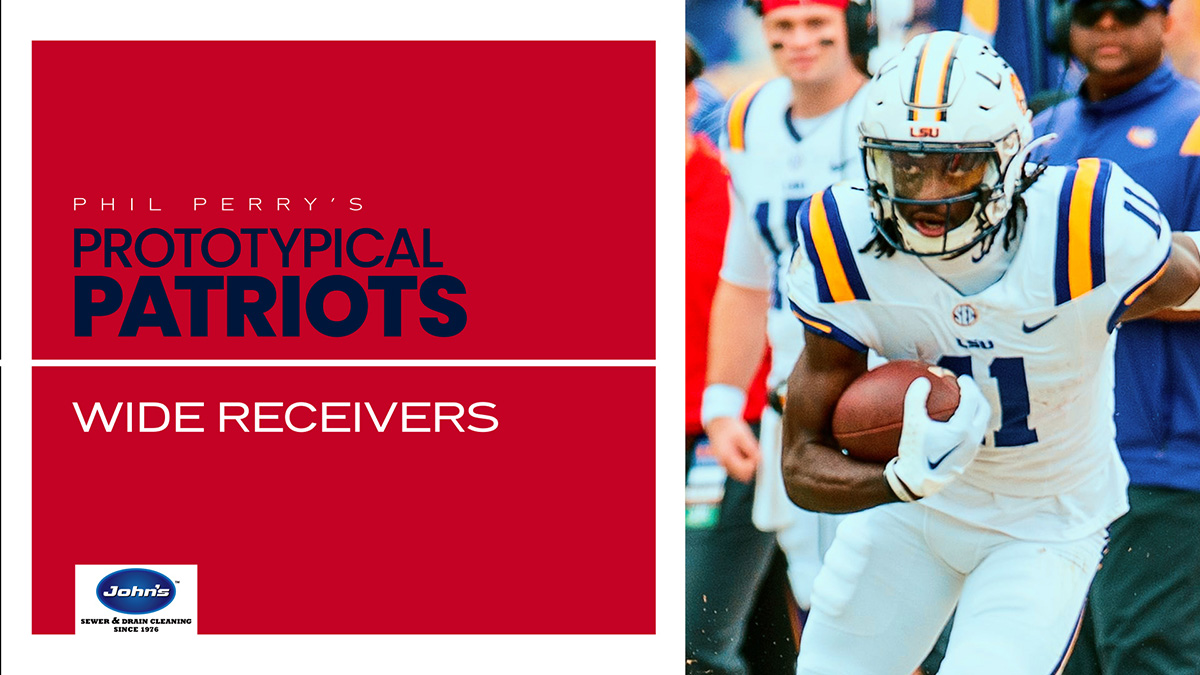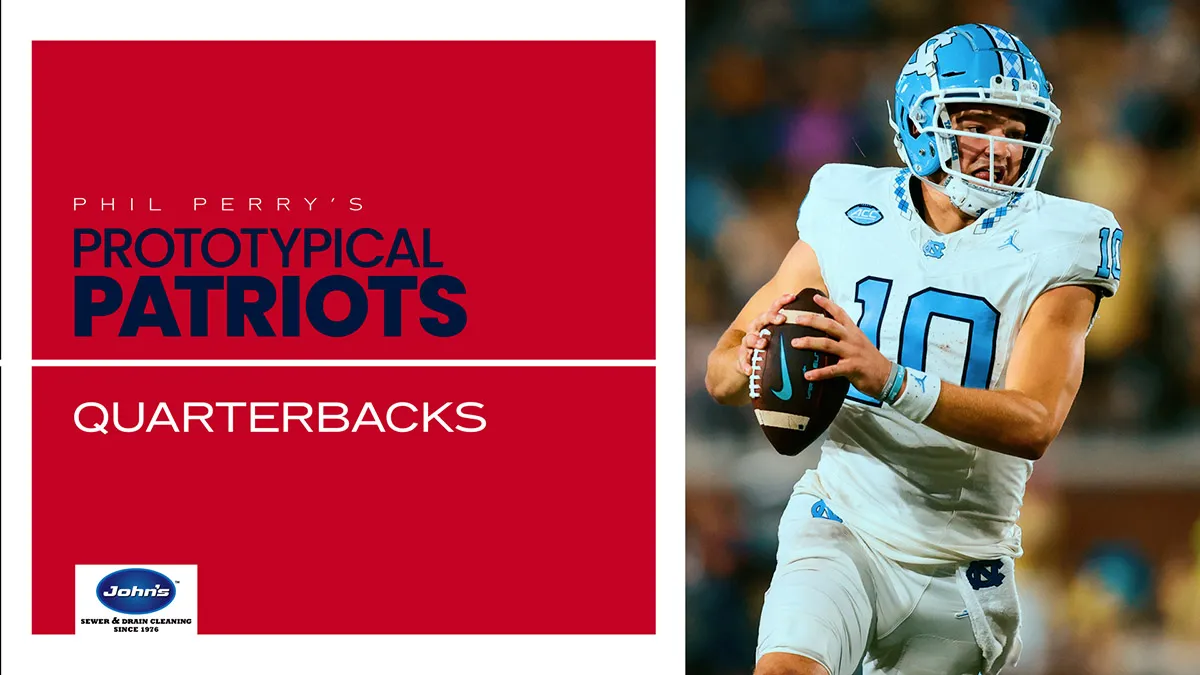For a long time, putting together our Prototypical Patriots series was relatively self-explanatory. We had about two decades of drafts run by Bill Belichick to analyze what he preferred at certain positions.
What were the physical or production-related thresholds he seemed to value at quarterback? Receiver? Tackle? Pass-rusher? Corner?
The more picks Belichick made, the more information we had, and -- theoretically -- the more we could zero in on the players Belichick coveted on draft weekend.
Stay in the game with the latest updates on your beloved Boston sports teams! Sign up here for our All Access Daily newsletter.
Now? The entire process is a little tougher.
Branches of the Wolf tree
De facto Patriots general manager and director of scouting Eliot Wolf has no track record as a franchise's primary front-office decision-maker. It's not entirely clear what he'll prefer on a position-by-position basis.
All we can do, then, is work off clues from personnel chiefs alongside whom Wolf has studied in the past. That includes his father, Ron Wolf, who built the Packers in the early 1990s and beyond.
The elder Wolf tutored the likes of Ted Thompson, John Dorsey, John Schneider, Reggie McKenzie, Scot McCloughan and Brian Gutekunst. Aside from McCloughan, who left the Packers in 1999, the younger Wolf worked with all of those future general managers in Green Bay. He worked directly under Dorsey in Cleveland as assistant GM.
As we go through this year's Prototypical Patriots series, we'll use evidence from all the branches of the Ron Wolf executive tree, pointing out what they valued in their early-round selections.
PERRY'S PROTOTYPICAL PATRIOTS SERIES
The prototypical Wolf-tree tight end
At tight end, there are 11 players who were drafted by a member of the Wolf executive tree in the first, second or third rounds. We have official pre-draft measurements for all of them, thanks in part to the extensive library from Kent Lee Platte's site RAS.football.
Of those 11 players, here's what we can say the Wolf tree has coveted at tight end.
On average, these players checked in at 6-foot-4, 252 pounds. They ran, on average, a 4.72-second 40 time and clocked a short-shuttle time of 4.36 seconds. They had average jumps of 34 inches in the vertical and 9-feet-11 in the broad. A player at that position with those measurements would be given a strong Relative Athletic Score of 8.36.
Per Platte's RAS metric, one of the closest comps to this composite average Wolf tree tight end would be Austin Hooper, who was just signed by Eliot Wolf as a free agent.
When taking a glance at all 11 players these Wolf types drafted relatively early, there are a couple of trends that stick out. They like size. And specifically players who check in at 250 pounds or more. Of the 11 studied, only two -- Josiah Deguara and Jermichael Finley -- didn't eclipse the 250-pound mark.
These execs also seemed to value some baseline quickness requirement: 10 of the 11 players studied clocked short-shuttle times before the draft, and nine of those came in under 4.50 seconds.
Who fits the suit?
Were you to look at this year's draft class and remove all the tight ends who don't tip the scales at 250 pounds, you'd suddenly have a much smaller group. That collection gets whittled down further when looking at the bigger bodies who also had shuttle times that came in under 4.50 seconds.
Those will be the two measurements we weigh most heavily here in trying to determine our "prototypes" at the position since some of the other metrics are all over the map.
Schneider's third-rounder for the Seahawks in 2016, Nick Vannett, ran a 4.89-second 40. McCloughan's first-round freak at tight end for the 49ers in 2006, Vernon Davis, blazed a 4.38 40. Finley jumped just 27.5 inches in the vertical somehow, Meanwhile McKenzie's third-rounder in 2015, Clive Walford, hit 35 inches in that particular event before the draft.
Both Luke Musgrave (6-foot-6, 253 pounds, 4.41-second shuttle) and Tucker Kraft (6-foot-5, 254, 4.29) -- Day 2 picks of the Packers last season -- hit the weight and shuttle markers relatively easily. So did Dorsey's third-round selection for the Chiefs back in 2013, Travis Kelce (6-foot-5, 255, 4.42).
With further ado, let's get to the options who fit the bill. We identified five.
Theo Johnson, Penn State (6-foot-6, 259 pounds)
Arguably the most impressive athlete at the position in this year's class, Johnson carries with him a whopping 9.93 RAS due to his size and eye-opening explosiveness. He recorded a 39.5-inch vertical and a 10-foot-5 broad jump at this year's combine. He also clocked an impressive 4.57-second 40 and a (for our purposes) noteworthy 4.19-second shuttle time.
If Eliot Wolf is after traits at this position, Johnson has them. He may need a little encouragement when it comes to his work in the running game, but he has the movement skills to be a weapon at a position that seems as reliant on athleticism as any other in the sport.
Ben Sinnott, Kansas State (6-foot-4, 250 pounds)
Sinnott just barely gets into the club this year based on his frame. But his athleticism is more than worthy for this list. He posted big-time jumps of 40 inches in the vertical and 10-foot-6 in the broad -- in the 97th and 94th percentiles, respectively -- and then put up a very quick shuttle time of 4.23 seconds.
Sinnott isn't going to be blowing hardened defensive ends off the line of scrimmage one-on-one in the running game at the next level. But if you can get him on the move? In an Alex Van Pelt scheme that may rely on horizontal movement along the line of scrimmage? He has enough grit to compete there.
And as a receiver, he appears to have the size and hands to be a reliable target for whichever quarterback is behind center in Foxboro, while also bringing enough juice to the table to create after the catch.
AJ Barner, Michigan, 6-foot-6, 251 pounds
His 4.41-second shuttle time isn't going to blow anyone away. But it is enough to land him here. Add in a 7.02-second three-cone time, and there's some real quickness to work with there.
He also has experience playing in-line as part of a pro-style offense -- not something all prospects at this position bring with them to the NFL -- that could make him attractive to Eliot Wolf and the Patriots front office. He's not the most dynamic receiver on this list this year, but he blocks well enough to make him a real dual threat.
If New England feels he can do enough as a chain-mover when absolutely necessary, they could turn to him as a depth option on Day 3 of the draft or soon after.
Tip Reiman, Illinois (6-foot-5, 271 pounds)
Don't be thrown off by that weight. Reiman can scoot. His 1.55-second 10-yard split ranked him in the 91st percentile. He also posted a 4.26-second shuttle time and a 7.02-second three-cone that were extremely impressive (both ranked him in the 77th percentile) for someone with his size.
Reiman was a walk-on for the Illini and eventually earned the title of captain in 2023. He'll block. He'll play special teams. And if his hands are dependable enough, he could be a big-bodied target in the passing game.
Don't be stunned if you hear the Patriots call his name on Day 3 given his mentality and his rare physical tools.
Austin Stogner, Oklahoma (6-foot-6, 254 pounds)
Thought this fifth spot would be reserved for Iowa tight end Erick All, didn't you? Well... he probably does deserve it at 6-foot-4, 252 pounds and with enough quickness to be viewed as a capable route-runner when healthy. But he's recovering from an ACL he tore in October. Therefore he hasn't been able to test. Therefore it's unclear whether or not he would've satisfied the thresholds laid out here to make this list of "prototypes."
Stogner, though? Stogner does. He may end up an undrafted signee. But his size and good-enough athletic traits (4.39-second shuttle) land him here. He caught 17 passes for 196 yards and a score last year for the Sooners.



